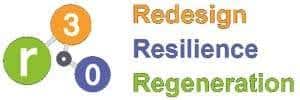Innovating sanitation infrastructure is essential for creating sustainable living environments (Govindaswamy & Rangappa, 2023). Modern systems go beyond mere waste disposal; they help conserve water, reduce greenhouse gas emissions, and protect public health (WHO, n.d.). By integrating new technologies such as water recycling, renewable energy, and decentralised treatment, we can build resilient solutions that serve both urban and rural communities (Tuqan & Mann, 2024). These efforts align with the principles of a Regenerative Economy, a business model that aims to maximise the value of resources while minimising waste by reusing them as much as possible. Transitioning from a linear to a Regenerative Economy is one of the THRIVE Framework’s 12 Foundational Focus Factors. The Foundational Focus Factors are the strategies THRIVE has developed through critical thinking to guide humanity towards a thrivable future.
Sustainable sanitation not only supports environmental goals but also promotes social equity by ensuring everyone has access to safe and dignified hygiene facilities. A large number of people around the world still do not have access to adequate water, sanitation, drainage, and solid waste disposal services. This shows that traditional sanitation methods are not enough, and sustainable sanitation provides a better solution. Poor sanitation is directly connected to all major global concerns, including growing inequality, the loss of natural resources, environmental degradation, and climate change. Sustainable sanitation is a prerequisite for societal advancement, economic prosperity, and a viable environment (Khandelwal, 2024).

Source: Kum & Tan, 2025
This approach also supports Values-Based Innovation, which is one of the THRIVE Framework’s 12 Foundational Focus Factors. Values-Based Innovation, emphasises creating a world which is sustainable and indeed, thrivable. Values-Based Innovation acts as a guiding standard by bringing together strategies grounded in shared ethical values like fairness, inclusion, and environmental care. These shared values are essential because they ensure solutions benefit everyone and drive the actions needed to achieve sustainability and thrivability. In this way, Values-Based Innovation creates a future where people and the planet not only survive but truly thrive together.
The Importance of Sanitation Infrastructure in Sustainable Living
Sanitation systems are an essential approach to promoting public health, preserving natural resources, and minimising environmental impact. By prioritising water conservation, waste reduction, energy efficiency, biodegradability, and public health, sustainable sanitation practices can help create a cleaner, healthier, and more sustainable environment for all. Examples of sustainable sanitation practices include composting toilets, wetlands for wastewater treatment, and rainwater harvesting (NetsolWater, n.d.). In many developing countries, poor sanitation spreads disease and harms public health. Open defecation pollutes water sources and causes outbreaks. Sustainable systems are key to protecting health in urban areas (Bose et al., 2024). Sanitation, according to the World Health Organization, can be defined as infrastructures, facilities, or services provided for the safe management of human excreta emanating from the toilet via its handling, storage, and treatment onsite or off-site by conveying the same waste safely to the end use or disposal (Affam & Ezechi, 2022).

Source: Koul, 2016
Sustainable sanitation systems are designed to minimise environmental impact. For example, modern wastewater treatment plants not only treat sewage to remove harmful pathogens and pollutants but also recycle water for non-potable uses such as irrigation (AAA Sanitation, 2024). Instead of viewing waste as a problem to be disposed of, cities are beginning to see it as a resource. For instance, biogas plants convert organic waste into energy, reducing the reliance on fossil fuels and contributing to a city’s energy sustainability. Similarly, treated sewage sludge can be used as fertiliser, enriching soils and promoting sustainable agriculture in urban and peri-urban areas (AAA Sanitation, 2024; AAA Sanitation, n.d.).
Challenges in Current Sanitation Systems and Their Environmental Impact
Despite the clear benefits of sanitation systems, there are significant challenges to their implementation in sustainable city development. Rapid urbanisation, particularly in developing countries, often outpaces the development of sanitation infrastructure, leading to inadequate coverage and overstressed systems. Additionally, climate change poses new risks, with extreme weather events such as floods and droughts threatening the integsustarity of sanitation systems (AAA Sanitation, 2024).
Financing is another major challenge. Building and maintaining sustainable sanitation infrastructure requires significant investment, which is often lacking, particularly in low-income countries. However, innovative financing models, such as public-private partnerships and international development aid, are providing new opportunities for cities to invest in sanitation. Technological innovation is also playing a critical role in overcoming these challenges. For example, decentralised sanitation systems, which treat waste at the source rather than relying on large centralised facilities, are becoming more popular in urban areas. These systems are often more affordable and easier to maintain, making them a viable option for rapidly growing cities (AAA Sanitation, 2024).

Source: Hill, 2025
Innovative Solutions: Eco-Friendly Sanitation Technologies
Water scarcity is an escalating crisis affecting billions globally. As populations grow and climates change, the water demand continuously strains existing supplies. This crisis not only impacts daily life but also stifles economic growth and development. Water scarcity is triggered by a variety of complex factors, from natural variances in rainfall to mismanagement of resources. While traditional methods of addressing water shortages, such as drilling deeper wells or constructing larger dams, are still prevalent, they are not always sustainable or effective in the long run. Internet of Things (IoT) solutions, remote monitoring, and data analytics are increasingly being integrated into sanitation infrastructure, offering new insights and efficiencies. IoT-enabled sensors can provide real-time data on water flow and quality. These sensors facilitate prompt responses to issues such as leaks or contamination, thereby improving system performance and resource management (The Water Page, 2025).
Automatic Variable Filtration
Automatic Variable Filtration (AVF) offers a smart and effective solution to the clean drinking water crisis. It works on a simple principle: the influent flows upward while the filter media flows downward. This method filters water efficiently without extra cleaning or filtration steps, making the process easy and resource-efficient. AVF stands out for being affordable and energy-efficient. It doesn’t use power or moving parts, thanks to its mechanical simplicity. Its flexibility makes it a promising technology for tackling large-scale water shortages and quality problems. AVF is already used in wastewater treatment, municipal water systems, and as a pre-treatment for desalination (Tigernix Australia, n.d.; Waterman Engineers Australia, n.d.).

Source: Waterman Engineers Australia, n.d.
Water Purification Utilising Bioaugmentation
Bioaugmentation is becoming a popular solution for the global clean water crisis, especially in wastewater treatment. This method uses beneficial microorganisms to break down pollutants like oils and carbon compounds in wastewater. Adding safe bacteria and enzymes makes the water suitable for different uses. Bioaugmentation also supports sustainable wastewater practices. It can help produce clean drinking water and synthetic fertilisers. However, the process involves several steps to safely remove the microorganisms after they finish their job (Monera Technologies, n.d.; Tigernix Australia, n.d.).

Source: Monera Technologies, n.d.
Photocatalytic Water Purification
Photocatalytic water purification is a popular solution to the global water crisis. This method uses photocatalysts and ultraviolet (UV) light to quickly remove toxic substances and impurities from water. It works efficiently under mild conditions, meaning it operates without high temperatures, pressure, or harmful chemicals, which reduces its environmental impact and makes it a green and eco-friendly technology. Because it is simple and cost-effective, photocatalysis offers a practical way to purify water. It can remove many contaminants, including pesticides, bacteria, viruses, dyes, and crude oil (Water & Wastewater, n.d.; Tigernix Australia, n.d.).
Water Conservation and Wastewater Treatment in Sustainable Sanitation
Rapid population growth, urbanisation, and increased food production are putting serious pressure on our limited freshwater resources. To support sustainable development, we must treat and reuse wastewater. That’s why it’s essential to improve wastewater management and advance treatment technologies. We must also ensure that reusing wastewater, especially in agriculture, does not risk public health (Maggiore, 2015).
Access to safe water, sanitation and hygiene is the most basic human need for health and well-being. Investments in infrastructure and sanitation facilities, protection and restoration of water-related ecosystems, and hygiene education, are among the necessary steps to ensure universal access to safe and affordable drinking water for all by 2030. Improving water-use efficiency is one of the keys to reducing water stress (United Nations, n.d.).
To understand how much wastewater we produce each day, just think about how often you use water. Each of these everyday activities turns clean water into wastewater. To reuse this water safely, we must treat it properly. When untreated wastewater flows into rivers or oceans, a common but often overlooked issue, it can harm our limited freshwater supplies and fragile ecosystems. Wastewater is key to conserving water, and each of us plays a role in making sure it’s treated the right way (Maggiore, 2015).

Source: Maggiore, 2015
Case Studies: Successful Sanitation Innovations Around the World
Durban Water Recycling Project
Water scarcity in the province of KwaZulu-Natal in South Africa led to the municipality requiring assistance with the treatment of domestic and industrial sewage and wastewater to a near potable standard for use in industrial processes. Industrial players in the area were consuming high quantities of water and discharging wastewater into the ocean. The operation began in May 2001 (and is still in operation), with the major benefits including a reduction in the overall industrial consumption of potable water and a decrease in the amount of treated sewage being released into the environment (Veolia South Africa, n.d.).
Condominial Sewer Systems
Condominial water and sewerage systems use simple designs and involve communities working with service agencies during planning and building. The name comes from “condominium,” meaning shared housing areas (SSWM, n.d.).

Source: Eawag et al., n.d.
Brazil is a leader in the development of cost-effective, simplified water and sanitation systems for densely populated urban settings called condominial water and sewerage systems. In Salvador, Bahia, Brazil, the installation of more than 1,000 km of condominial sewer network pipes resulted in city-wide health impacts, including reduced intestinal parasites and childhood diarrhoea (Stauber et al., 2022).
Sanitation Marketing
Sanitation marketing in Bangladesh focuses on promoting the adoption of improved sanitation facilities through market-based approaches, rather than solely relying on subsidies or public provision. This strategy aims to create a sustainable market for sanitation products and services, making them accessible and affordable to a wider population (WSP, 2022).

Source: Water Communications, 2014
Building the Future: Policies and Practices for Sustainable Sanitation Systems
Sustainable sanitation systems are crucial for public health, environmental protection, and economic development. These systems involve a holistic approach, considering the entire sanitation chain and incorporating principles of sustainability, including resource recovery and climate resilience. Policies and practices should focus on universal access, efficient resource management, and strengthening climate resilience (Lazzati et al., 2024).

Source: UNICEF, n.d.
Sanitation systems should be designed to withstand the impacts of climate change, including extreme weather events, and ensure continuity of service (WaterAid, 2023). Environmental sanitation is more than just a matter of aesthetics; it is a critical component of public health, quality of life, and long-term development. A clean and well-maintained environment contributes to the physical and psychological well-being of individuals while fostering a sense of community pride and responsibility (Re-leaf, 2024).
Conclusion and Call to Action
Innovative sanitation solutions are key to building a healthier, more resilient, and thrivable future. As water scarcity, urbanisation, and climate change intensify, upgrading our sanitation infrastructure is no longer optional; it’s essential. Therefore, By adopting advanced, eco-friendly technologies and inclusive practices, we can protect public health, preserve natural resources, and ensure dignity for all. Now is the time to act. To achieve this, governments, researchers, engineers, and communities must collaborate to scale up sustainable sanitation systems. Furthermore, let’s invest in innovation, support equitable access, and make clean water and safe sanitation a universal reality. Partnering with charities or initiatives like charitywater (CharityWater, n.d.), WaterAid (WaterAid, n.d.), and UNICEF Water, Sanitation, and Hygiene (UNICEF, n.d.) strengthens efforts to provide clean water and sanitation for all. The future of sustainable living depends on it.
Achieving THRIVE goals
Innovating sanitation infrastructure for sustainable living supports the Regenerative Economy and Values-Based Innovation. This topic also aligns with SDG6: Clean Water and Sanitation, and SDG9: Industry, Innovation, and Infrastructure.
Regenerative Economy:
A Regenerative Economy is an alternative approach to living within Earth’s natural means while still providing for the population. Thus, in a Regenerative Economy, goods are produced, used, and reused. Innovating sanitation infrastructure supports a Regenerative Economy by turning waste into valuable resources such as compost, biogas, and recycled water. This helps reduce pollution, conserve water, and restore soil health, making systems circular and thrivable. Such solutions also create green jobs, improve public health, and empower communities. By closing resource loops and reducing environmental impact, innovative sanitation plays a key role in building resilient and sustainable living environments.
Values-Based Innovation:
Values-Based Innovation as an approach seeks to act as a guiding standard. It brings together strategies infused with a common ethical basis and shared values. Focusing on Values-Based Innovation is vital because it helps businesses operate ethically, build a positive reputation, engage employees, and create products that benefit society. It also reduces risks, ensures regulatory compliance, and promotes long-term sustainability. By aligning innovation with values, companies can adapt to challenges, build customer loyalty, and have a positive impact globally. In essence, it’s about doing good whilst doing well in business. This means designing sanitation solutions that not only solve technical problems but also respect cultural norms, promote social inclusion, protect ecosystems, and address the needs of vulnerable populations. By putting people and the planet at the center of innovation, values-based approaches help create more just, acceptable, and lasting sanitation systems that truly support sustainable living.
This topic also aligns with SDG6: Clean Water and Sanitation and SDG9: Industry, Innovation, and Infrastructure
SDG6: Clean water and sanitation
Innovating sanitation infrastructure directly supports SDG6: Clean Water and Sanitation, which aims to ensure clean water and sanitation for all. Modern, sustainable systems help safely manage wastewater, reduce contamination of water sources, and promote water reuse. By improving access to safe and efficient sanitation, these innovations protect public health, conserve water, and support environmental sustainability, making them essential for achieving the goals of SDG6.
SDG9: Industry, Innovation, and Infrastructure
Innovating sanitation infrastructure supports SDG9: Industry, Innovation, and Infrastructure, which focuses on building resilient infrastructure, promoting inclusive and sustainable industrialisation, and fostering innovation. By developing modern, efficient, and decentralised sanitation systems, we create smart infrastructure that is adaptable, environmentally friendly, and accessible to all communities.
SDG6 and SDG9 highlight the need for clean water, sanitation, and strong infrastructure, but they often miss key solutions for sustainable living. SDG6 focuses on access and safety, yet pays little attention to reusing resources or restoring the environment. SDG9 encourages innovation and infrastructure, but may ignore affordable, inclusive sanitation options for low-resource communities. Considering innovative sanitation infrastructure alongside Regenerative Economy and Values-Based Innovation transcends SDG6 and SDG9 by restoring ecosystems, reusing resources, and putting people and the planet first. They help shift from short-term sustainability to long-term thrivability, making sanitation systems more inclusive, circular, and future-ready.
A Thrivable Framework
The THRIVE Framework examines important global issues, evaluating potential solutions in relation to the overarching goal of thrivability. It is about making predictive analyses using modern technology that supports the transformation to environmental and social sustainability. Innovating sanitation infrastructure for sustainable living supports a Regenerative Economy by turning waste into useful resources and protecting the environment.
It also reflects Values-Based Innovation by focusing on fairness, community needs, and long-term well-being. To learn more about how THRIVE Project is researching, educating, and advocating, visit our website for more.
You can follow our informative blog and podcast series and learn about our regular live webinars, featuring expert guests in a myriad of fields. The articles offer emerging insights on transformative frameworks; the Podcast features global voices reimagining value and success; and the Whitepapers present evidence-based research on complex societal transitions. Also, live Webinars and Workshops bring together practitioners and scholars to co-create real-world solutions. Sign up for our newsletter for regular updates.























